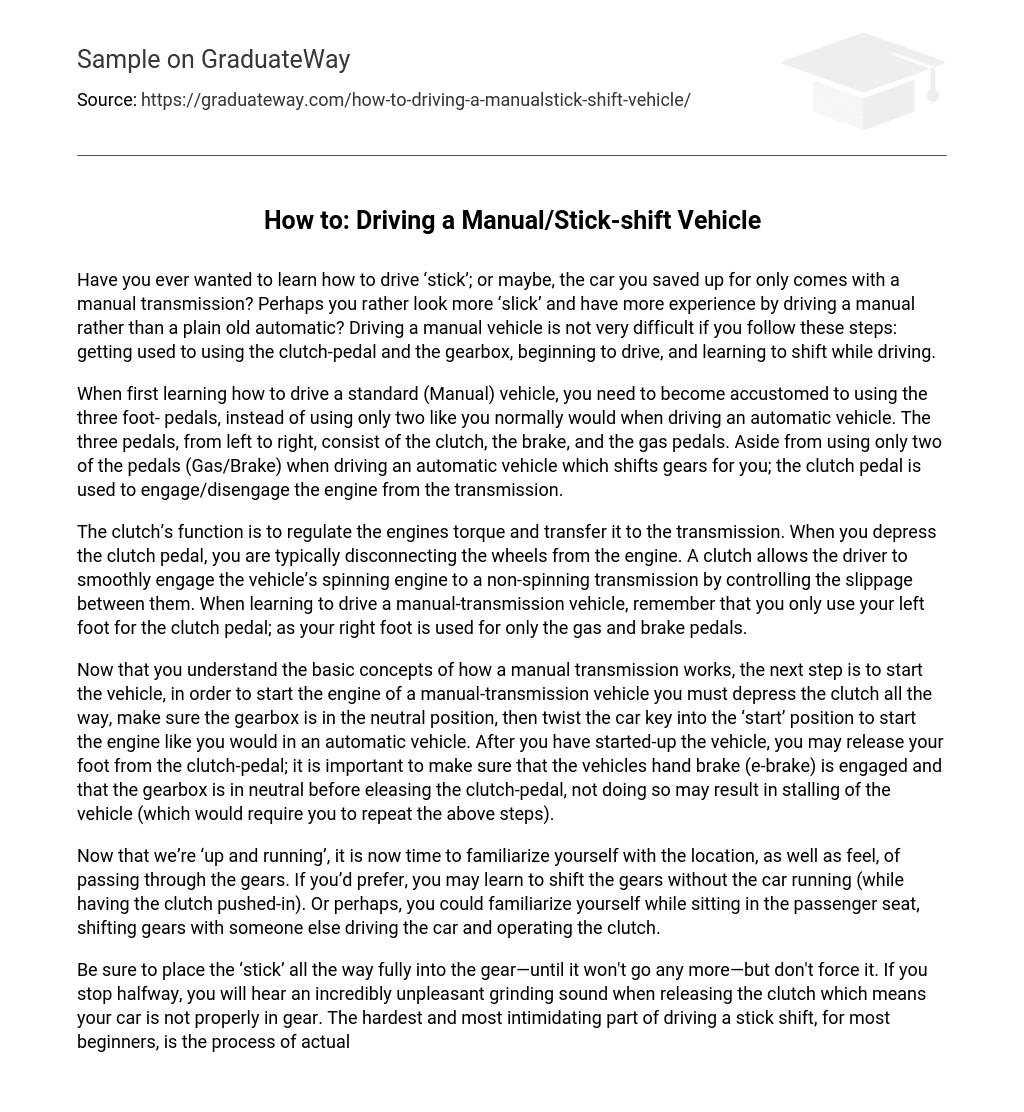If you’ve ever desired to learn how to drive a manual transmission or if the car you’ve saved up for is equipped with one, this guide is for you. You might prefer the added experience and sleekness that comes with driving a manual instead of a regular automatic. The process of driving a manual car can be made simple by following these steps: acquainting yourself with the clutch pedal and gearbox, starting to drive, and mastering shifting while driving.
When initially learning to drive a standard (Manual) vehicle, one must get used to operating the three foot-pedals rather than just two, as is customary when driving an automatic vehicle. In a standard vehicle, the three pedals are situated from left to right and include the clutch, brake, and gas pedals. While driving an automatic vehicle that automatically shifts gears for you only necessitates the use of two pedals (Gas/Brake), in a standard vehicle, the clutch pedal is employed to connect or disconnect the engine and transmission.
The clutch is responsible for managing the engine’s torque and transferring it to the transmission. Depressing the clutch pedal usually separates the wheels from the engine, enabling the driver to smoothly connect the spinning engine to a stationary transmission by controlling the slippage between them. When driving a manual-transmission vehicle, it is important to remember that only your left foot operates the clutch pedal, while your right foot is reserved for the gas and brake pedals.
Now that you have a grasp of the basic concepts of how a manual transmission works, the next step is to start the vehicle. To start the engine of a manual-transmission vehicle, you must depress the clutch fully, ensure that the gearbox is in the neutral position, and then twist the car key to the ‘start’ position, just like you would in an automatic vehicle. Once you have successfully started the engine, you can release your foot from the clutch pedal. However, it is crucial to engage the vehicle’s hand brake (e-brake) and ensure that the gearbox remains in neutral before releasing the clutch pedal. Failure to do so may result in stalling the vehicle, which would require you to repeat the aforementioned steps.
Now that we have begun operating the car, it is important to get acquainted with the location and sensation of shifting gears. If desired, one can learn to shift gears without the engine running (while keeping the clutch depressed). Alternatively, one can become familiar with gear shifting by sitting in the passenger seat and operating the clutch while someone else drives.
When driving a stick shift, make sure to fully insert the ‘stick’ into the gear. Do not force it, but make sure it goes all the way in. If you only stop halfway, you will hear a grinding sound upon releasing the clutch, indicating that the car is not properly in gear. The most difficult and daunting aspect of driving a stick shift, especially for beginners, is getting the car moving in first gear. It may take some time to grasp the right amount of pressure on the gas pedal and the slow release of the clutch pedal necessary for engaging first gear and starting to move.
It is important to accept that stalling the car is inevitable when learning how to drive a stick-shift, just like most beginners. Stalling is a necessary part of becoming a skilled stick-driver and joining the stick-driving “Brotherhood/Sisterhood”. While it may be frustrating to stall multiple times, once you get the car moving, shifting gears becomes easier. So let’s get started! It’s recommended to practice in an empty parking lot.
When learning to drive a stick shift, it is recommended to practice in an area with few bystanders and other vehicles, and where there is a flat surface. Empty parking lots are often the ideal location for many stick-shift drivers to learn. It can also be helpful to have a friend in the passenger seat who knows how to drive a manual transmission, as they can provide guidance and support during the frustrating moments. Before starting the car, remember to press the clutch and brake pedal, ensure that the gearbox is in neutral, and engage the hand-brake (e-brake).
When starting a vehicle with a manual transmission, always remember to have the clutch pressed-in while turning the key to start the car. Unlike with an automatic transmission, it is not necessary to have your right foot on the brake to start the car, although it is a good habit. Start the car by pushing down the clutch pedal with your left foot and pressing on the brake with your right foot. Release the hand-brake (e-brake), shift into first gear, then slowly release the clutch while applying some pressure on the gas pedal. Houston, we have lift-off.





